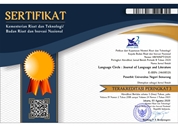DEVELOPING THEMATIC ENGLISH MULTIMEDIA FOR TEACHING VOCABULARY TO YOUNG LEARNERS
(1) Islamic Centre Purwodadi, Grobogan
Abstract
The observed inappropriateness comes from textbooks used in teaching young learners are too difficult, dominated by written form, unspecific, and decontextualized interactive multimedia. Hence, the researcher would like to develop Thematic English Multimedia (TEM) for teaching vocabulary to young learnersat kindergarten B of Islamic Centre Purwodadi, Grobogan. This study employed R&D Design proposed by Borg and Gall (2003:772). Seven stages employed were information and research collecting, planning, developing, validating, revising, try out, and producing final TEM. Observation, interview, validation, performance-based assessment, and pre also post-test were administered to collect data. From results of collected data, they were found that applying TEM got positive perspectives toward teaching and learning process. In line with above statements, TEM is effective and feasible to teach young learners at kindergarten B of Islamic Centre Purwodadi, Grobogan.
Keywords
Full Text:
PDFReferences
Allessi, S. and Trollip, S. 2001. Multimedia for Learning: Methods and Development. Massachussets: Allyn & Bacon.
Badrova, E. and Leong, D. 2003. The Importance of Being Playful. Educational Leadership, Vol 63 No.1. [Accessed 29/08/2012].
Beatty, K. 2003. Teaching and researching CALL. Essex: Pearson Education Limited.
Bond, M. and Wasik, B. 2009. Conversation Stations: Promoting Language.Development. Young Children. Early Childhood Education Journal.No. 36. Available on http://www.ECEJ.com/ [Accessed 10/09/2012].
Borg, W. and Gall, M. 2003. Educational Research: An Introduction. 7th edition. New York: Longman.
Bourke, J. 2006. Designing a Topic-Based Syllabus for Young Learners. English Language Teaching Journal. Available at http://www.elt.com/. [Accessed 11/09/2012].
Bransford, J., Brown, A. and Cocking, R (eds). 2000. How People Learn: Brain, Mind, Experience and School. Expanded edition. Washington, D.C: National academic Press.
Bredekamp, S. 2011. Effective Practices in Early Childhood Education: Building a Foundation. Boston: Pearson.
Bredekemp, S. and Copple, C. (Eds). 1997. Developmentally Appropriate Practice in Early Childhood Program. Revision edition. Washington, D.C: National Association for the Education of Young Children.
Cameron, L. 2001. Teaching Languages to Young Learners. Cambridge: Cambridge University Press.
Cohen, L., Manion, L., and Morrison, K. 2007. Research Method in Education. 6th edition. Oxon: Routledge.
Christ, T. and Wang, X. 2010. Bridging the Vocabulary Gap: What the Research Tell us about Vocabulary Instruction in Early Childhood Education. [Accessed 12/09/2012].
Hick, S. 1997. Benefits of Interactive Multimedia Courseware. Trican Multi-media Solution Inc. online at http:www.google/benefit interactive multimedia for learning/htm.[Accessed 05/10/2012].
Husty, S. and Jackson, J. 2008 Multi-Sensory Strategies for Science Vocabulary. Science and Children. Vol. 46. [Accessed 10/08/2012].
Kemp, J. 1997. Instructional Design : A Plan for Unit and Course Development. Belmont: Fearon-Pitman Publishers.
Nation, I. and Newton, J. 2009. Teaching ESL/EFL Listening and Speaking. New York City: Routledge.
Paul, D. 2003. Teaching English to Children in Asia. Quarry Bay: Longman Asia ELT.
Phillips, Sarah. 1993. Young Learners. Oxford: Oxford University Press.
Reilly, V. and Ward, S. 2011. Very Young Learners. Shanghai: Oxford University Press.
Rodgers, M. 1998. The Definition and Measurement of Innovation. Available at http://www.ecom.unimelb.edu.au/iaesrwww/home.html No.10. [Accessed 02/11/2012].
Santrock, J, et al. 2007. Educational Psychology. 2nd Canadian edition. Toronto: MCGraw-Hill Ryerson.
Scott, W. and Ytreberg, L. 1993. Teaching English to Children. New York: Longman.
Shin, J. 2011. Teaching English to Young Learners: Characteristics of Young Learners. Online at http: // www. teyl/characteristics/edu.html. [Accessed 13/09/2012].
Stemler, L. 1997 Educational Character-istics of Multimedia: A Literature Review Vol.6 No.3. [Accessed 02/10/2012].
Refbacks
- There are currently no refbacks.

This work is licensed under a Creative Commons Attribution 4.0 International License

